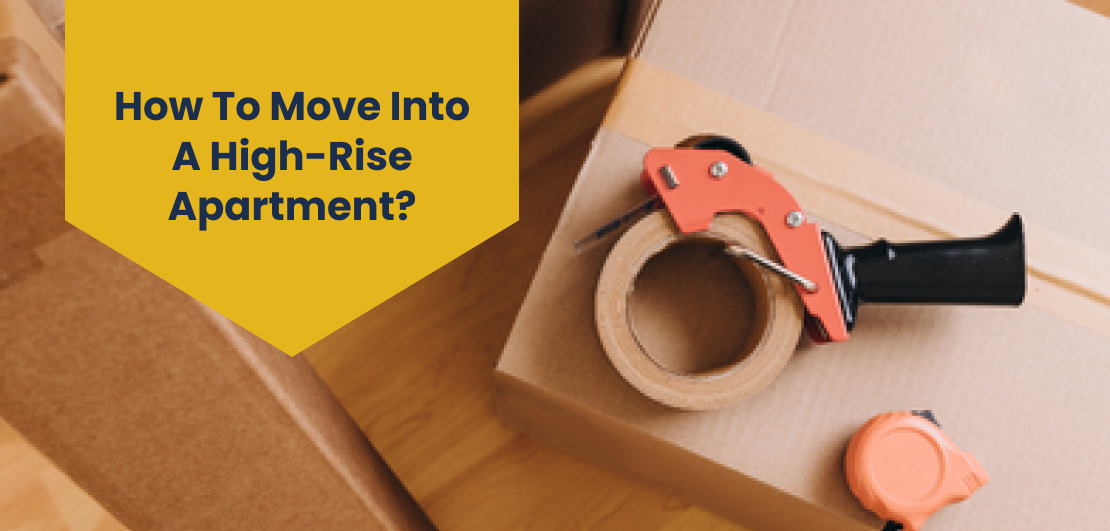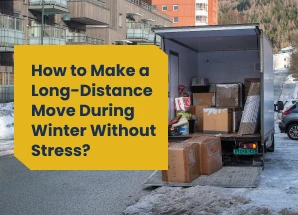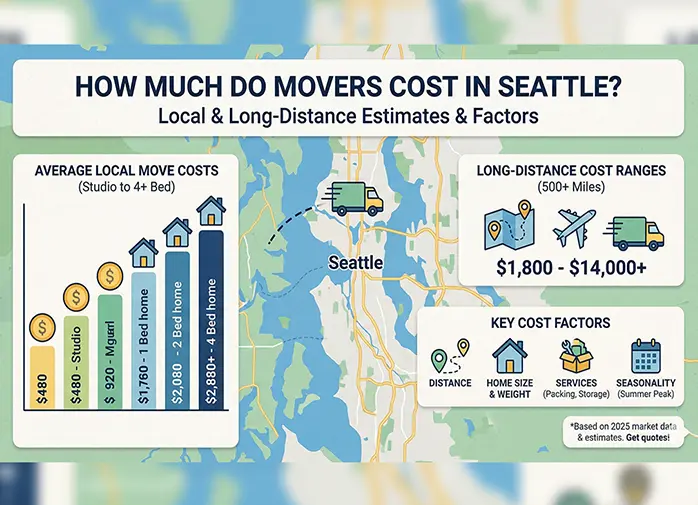How to Move into a High-Rise Apartment?

Moving into a High-Rise Apartment
Moving into a high-rise apartment is an exciting step that promises stunning views and modern amenities. However, it also presents unique challenges that require careful planning. There's a lot to consider, from dealing with limited parking and tight spaces to navigating building policies and securing the right moving tools.
With a simple checklist for moving into an apartment and a little planning, you can tackle these challenges. Let’s delve into the key things to keep in mind when moving into a high-rise apartment and explore some simple tips to make the process as smooth as possible.
1. Get Ready for Your Move Early
The first step to a smooth move into a high-rise apartment is planning ahead. High-rise apartments often come with certain restrictions and rules that might not apply in other types of homes. These can include specific moving times, parking restrictions, or requirements for using the elevator. Here’s how you can plan:
- Check with the building management: Some buildings require you to book a time for your move. Ask about any restrictions, such as moving hours (e.g., weekends or weekdays only) and the use of service elevators.
- Make a checklist: Start creating a checklist of things you need to do. This includes notifying your current landlord, changing your address, and arranging for utilities to be transferred.
- Measure your furniture: High-rise apartments sometimes have narrow hallways and small elevator spaces. Before you move, measure your furniture and check if it will fit in the elevator or through doorways.
2. Hire a Moving Company or Rent a Truck
Moving into a high-rise apartment often means dealing with tight spaces and the need to carry heavy furniture up multiple flights of stairs or in and out of elevators. This can be a daunting task, especially if you don’t have the right equipment or experience. Here are some options for you:
- Hire a professional moving company: Hiring a professional moving company can take a lot of stress off your shoulders. They have the tools and expertise to move your items safely, including using special equipment to handle heavy furniture or fragile items.
- Rent a moving truck: If you prefer to handle the move yourself, renting a moving truck is an option. You can then gather a group of friends or family to help you pack and unload. Make sure to check if your building has any rules about truck parking and if there are any restrictions on the loading dock.
Tip: If you're planning a big move, Van Lines Move can help with everything from packing your belongings to safely transporting them, ensuring everything arrives at your new home in great condition. With our professional movers, we take the stress out of moving. Let us handle the hard work so you can focus on settling into your new space! Contact us!
3. Pack Smart and Label Everything
Packing can be the most time-consuming part of any move. However, when moving into a high-rise apartment, it’s important to pack smartly. Here are some tips for packing effectively:
- Use strong boxes: Choose sturdy moving boxes to avoid accidents and broken items. Don’t overpack boxes with too many heavy items, as they can break open.
- Label your boxes: Labeling boxes clearly is crucial. You can use color coding or simply write on the boxes what’s inside (e.g., kitchen items, bedroom, bathroom). This will make it easier for you to unpack when you arrive at your new home.
- Pack fragile items carefully: Use bubble wrap or old towels to protect fragile items like glassware, dishes, or electronics. Consider packing these items separately in special boxes to avoid any damage.
4. Consider Your Building’s Elevator and Access Rules
One of the main challenges of moving into a high-rise apartment is the elevator. Depending on your building, there might be specific rules for using the elevator during your move. Here’s what you should consider:
- Protect the elevator: Many buildings have protective covers for the elevator to prevent damage during a move. Ask the building management if they provide these or if you need to bring your own.
- Use the service elevator: Some high-rise buildings have a separate service elevator for moving purposes. Make sure you know which elevator to use, and reserve it ahead of time if needed.
- Elevator size: Some elevators are small, and it can be a challenge to fit larger pieces of furniture. If possible, try to disassemble bulky furniture before moving it to make it easier to carry.
Check out how to move into a building with no elevator!
5. Notify Utility Companies and Change Your Address
Before you move into your high-rise apartment, make sure your utilities are set up and that your address has been updated:
- Set up utilities: Contact your utility companies (water, electricity, gas, internet, etc.) to make sure services are connected at your new apartment before you move in. You don’t want to be without power or water after the move!
- Change your address: Update your address with the post office, banks, and any other important institutions to ensure you receive all your mail at your new apartment.
6. Prepare for Parking and Loading Areas
High-rise apartments often have limited parking and loading areas, so it’s important to be prepared:
- Reserve parking spots: If your building has designated parking spots for movers, make sure to reserve one ahead of time. This can save you time and stress when you arrive with your moving truck.
- Check loading zones: Some buildings have specific loading zones for moving trucks. These spaces are typically close to the building’s entrance and are reserved for unloading only. Ask your building management about these zones so you can avoid parking in unauthorized spots.
7. Take Care of Security and Safety Measures
High-rise apartments have higher security standards than most homes, and you’ll want to follow the rules to keep things running smoothly. Here are a few tips:
- Register your movers: Some high-rise buildings require that you register anyone who will be entering the building for your move. This could include movers or friends helping with the process.
- Bring ID: For security purposes, you may need to bring ID and sign in at the building’s front desk. Make sure to check with building management in advance.
- Keep the building clean: Moving can make a mess in the common areas of the building. Make sure to bring cleaning supplies to clean up after the move and keep things tidy.
Related Articles:
- Ultimate Moving Checklist for Families
- The Ultimate List of Essentials for Your First Apartment
- Five Things to Do Before and After Move
8. Unpack and Settle In
Once you’ve moved into your new high-rise apartment, the next step is to unpack and make it feel like home. Here’s how to settle in smoothly:
- Start with the essentials: Begin by unpacking the essential items like toiletries, a few clothes, and kitchenware. This will allow you to live comfortably while you work on unpacking the rest.
- Arrange furniture: Think carefully about how you want to arrange your furniture. High-rise apartments often have unique layouts, so take your time to figure out what works best in each room.
- Take advantage of the views: One of the best things about living in a high-rise apartment is the view. If possible, arrange your furniture so that you can enjoy the scenery.
Wrapping Up: Your High-Rise Move
Moving into a high-rise apartment can feel like a big task, but with some good planning, it doesn’t have to be stressful. Just focus on things like necessary building permissions, packing smart, and staying organized
Categories
- Long Distance Moving154
- Local Moving120
- Commercial Moving40
- Residential Moving34
- Last – Minute Moving25
- Moving Tips & Lifestyle10
- Furniture Moving9
- Moving Tips & How-To Guides8
- Moving services6
- Moving Cost5
- Moving Cost Calculator5
- Moving Costs & Budgeting5
- moving tips4
- state to state movers4
- Piano Moving3
- Car Transportation3
- Truck Rental3
- Local Move3
- Moving companies3
- best moving rates3
- cheap moving companies3
- affordable moving companies3
- full-service movers3
- Moving Cost Guides3
- Junk Removal2
- Moving Container2
- Senior Moving2
- Senior Relocation Moving Companies2
- Moving Tools2
- Moving Estimates2
- interstate moving2
- College Moving2
- Moving2
- Dorm Moving2
- cross-country move2
- International moving2
- Household moving2
- Moving Tips & State Guides2
- Moving Tips & Planning2
- Heavy Equipment1
- Senior Moving Services1
- office moving1
- office relocation1
- employee relocation1
- Car Transport1
- Vehicle Shipping1
- Car Shipping Services1
- Artificial Intelligence1
- Office Moving Services1
- Commercial Moving Companies1
- Corporate Moving Services1
- Corporate Movers1
- full-service moving companies1
- sustainable moving companies1
- green movers1
- Moving in US1
- Best places to move in 20251
- 2025 moving1
- Full-Service Moving Companies1
- College moving services1
- Moving to College1
- Tips for moving1
- donate1
- sell1
- Movers in California1
- Movers in Studio City1
- Moving to California1
- Laws about Moving into California1
- Moving Laws1
- House moving1
- packing1
- cheap moving ways1
- Moving guide1
- moving across countries1
- international relocation program1
- move out cleaning1
- right packing supplies1
- pack while moving1
- Apartment moving1
- PODS1
- moving out1
- state to state move1
- California movers1
- Truck Rental1
- US Territory Relocation1
- International Moving1
- Shipping & Moving Tips1
- Moving Tips1
- Relocation Guide1
- Moving Budget Guide1
- Relocation Guides & Incentives1
- Moving Tools & Equipment Guides1
- Moving Services & Options1
- Moving Tips & How-To Guides1
- Moving Day & Settling In1
- Mobile Home Moving1
- Moving Guide & Tips1
- Moving Tips & State Comparisons1
- Moving Tips & City Guides1
- Moving Tips & Cost Guides1
- Long-Distance Moving Tips1
- Moving Tips & Financial Planning1
- Moving Tips & Home Preparation1
- Vehicle Shipping & Auto Transport1
- Marketing & Lead Generation1
- International Moving Guides1
- San Francisco Moving Guide1
- NYC Moving1
- Local Movers1
- Budget Moving1
- Student Moving1
- Affordable Moving1
- Specialty Moving Guides1
- Local & Long-Distance Moving1
- Boston Moving Guide1
- Europe Relocation Guide1

 Local Movers
Local Movers Last-Minute Movers
Last-Minute Movers Junk Removal
Junk Removal Long Distance Movers
Long Distance Movers Piano Movers
Piano Movers Heavy Equipment
Heavy Equipment Commercial Movers
Commercial Movers Moving Container
Moving Container Car Transportation
Car Transportation Furniture Movers
Furniture Movers Truck Rental
Truck Rental Moving Cost Calculator
Moving Cost Calculator Moving Planner
Moving Planner Packing Calculator
Packing Calculator Moving Checklist
Moving Checklist Moving Insurance
Moving Insurance FAQ
FAQ Contact Us
Contact Us Moving Loan
Moving Loan About Us
About Us


.webp)








